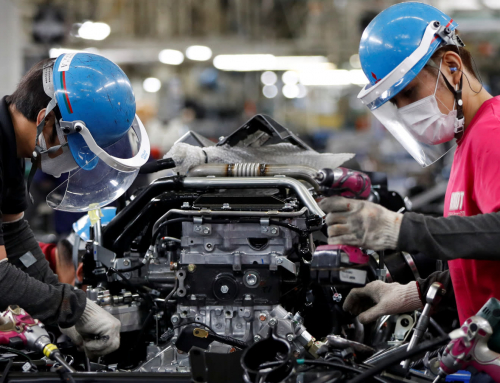MALAYSIA may not be lacking in terms of innovation and ideas. However, the country’s cor-porate sector’s inability to articulate those ideas into products with high commercial value to break into the global market has been an incessant stumbling block for the country’s efforts to drive the economy to innovation as they become a high-income nation.
Performance and Management Delivery Unit (Pemandu) CEO Senator Datuk Seri Idris Jala has long been calling for the rise of a Malaysian industrial regional champion.
“We can name a services champion ?Air Asia, but not an industrial champion,” said Pemandu s Economic Transformation Programme (ETP) di rector for innovation and investment Ku Kok Peng, urging the private sector to take the lead towards this end.
Industry Push Essential
The creation of such industrial champions hinge on private sector initiatives.
“Individual companies need to find ways to drive innovation so that ideas will morph into commercially-viable products. While the government puts in place a host of measures and incentives towards this end, onus is upon the private sector to lead the way and boost its own efforts to gain a global competitive edge,” Ku said.
“We must remember that manufacturing continues to be an important mainstay of the economy. We always get side-tracked that we have become a services-oriented economv (55%) but what a lot of people don’t realise is that half of the services are factory-based services (ie packaging, logistics, professional services and marketing).
“Having said that, the product has to be good, and the more products we have the more services we create,” he said.
Hence, Ku stressed the importance to grow the manufacturing sector to ensure the country has innovative products.
Efficiency: One of Malaysia’s Shortfalls
Ku said Malaysian products tend to be poor in quality compared to China, which has industrial champions like Huawei Technologies Co Ltd to boast of.
The Global Innovation Index (Gil) also suggests that Malaysia remains stagnant within the 30s ranking over the last three years. The Gil, jointly published by World Intellectual Property Organisation, Cornell University and global business school INSEAD, ranks the innovation performance of 143 countries and economies around the world based on 81 indicators, taking into account human capital required to achieve innovation, including skilled labour, the intersection of human, financial and technological capital, talent retention and mobilisation of highly educated people.
One of the stark issues facing the country is lack of efficiency.
“What are the inputs (in terms of investments for research and development (R&D)) against outputs ie the quality of the returns in innovation, from the perspectives of patents found, research papers published and university rankings. Qualitatively, it does show we’re not doing well. Efficiency ratio is not looking very good.”
A Quantitative Problem Too
Aside from this qualitative aspect, the country is also facing setbacks quantitatively? in terms of its R,D&C (research, development and commercialisation) spending, Ku pointed out.
According to World Bank data, the global average spend on R,D&C is 2% of a country’s gross domestic product (GDP) while for high-income nations it may peak to 3%. However, Malaysia’s spend on R,D&C is said to be lower than that of the average for middle-income nations.
“Numbers don’t lie. So the first issue is quantitative: we are not spending enough in R,D&C,” he said.
Commercialisation, Scaling-up and Embracing Risks
Innovation comes in where technology, value chains, marketplace are not mature. Therefore the facilitation is not just in the upscaling but, also in supporting the R,D&C.
“R&D, we are familiar with, but the ‘C – commercialisation ?that is the part where the scale up is really necessary. The risk is quite high because technology and applications are not mature, so the chances of the products failing are obviously high/’ Ku emphasised.
“What we need to do is take calculated risks and be prepared. Unlike mature activities, where you were taught to tolerate fewer failures, for innovation, you just have to tolerate a few more failures. Because if you do not try, you would never know. So you have to trv and be prepared. That’s all.”
Ku said that as ETP enters its fourth year of implementation, and the country is confident of reaching the high-income nation target before 2020, the government’s role is to execute and assist in the scaling up ?that includes removing the roadblocks that can lead to a scale-up.
“So, innovation will take us beyond 2020. Once we are a high-income nation and continue to grow the economy, innovation will take us to the next level”.
In terms of risks, he admitted that the execution risks will continue to exist. No matter how mature the markets/products are, there is still a chance of execution risks. But generally they are much lower and if managed well, one will not fail.
Benchmarking – China, Hungary and Korea
If you look at the giant in the region, Malaysia’s R&D is trending about half of what China’s doing, and China is a slightly high-medium income nation.
“Income wise, we are way ahead of China but look at where they are in terms of R&D expenditure as a percentage of GDP,” he said, tracing back to the 1990s, when both Malaysia and China were both middle incomes growing at a fast pace, active in manufacturing. “However, China soon began to spend a lot on R&D and innovation.” Hence, the birth of the country’s industrial champions.
To see why we need to pay attention on innovation and R,D&C, he cited the example of Hungary whose expenditure is similar to that of Malaysian, which is below the global average and certainly below the high-income economy average.
“You can see also qualitatively they have not been doing well in terms of trademark applications and patents ?if not flat, it went down. The net impact on that has been quite telling. We don’t know if this is something they can reverse in the near future. Quite clearly the trajectory was going down,” Ku illustrated.
While this may not be directly correlated or linked to innovation per se, there are perhaps some co-relations and it is good for Malaysia to reflect on how not to make the same mistake.
While Malaysia may have entered aggressively into the industrial sector at about the 0 same time as Taiwan and Korea in terms of being truly industrialised, he pointed out, “See where Korea is in terms of automotive, consumer electronics.
” Where did we go wrong?
“For example, we made our cars competitive for the local market. Korea meanwhile took their cars to the global market to find out what the market demands were, and as such innovated and evolved to meet global needs. They took the risks, and have since become globally competitive,” he said.
Measures in Place
While the country has not found solutions for all the issues, Ku said some of the measures meted out address some of the issues at hand.
In terms of investments, he said: “We clearly need to spend more and provide incentives for private companies to spend more in R,D&C”.
For instance, Malaysian Industrial Development Authority (Mida) incentives for private companies allow for companies that are ready to scale-up to venture into large-scale commercialisation. “The existing facility offers matching grants for R&D activities,” he said.
Similarly, Agensi Innovasi Malaysia (AIM) went on to set up the Public Investment Fund Committee (Jawatankuasa Pelaburan Dana Awam – JKPDA), which facilitates the public sector investment R&D fund and ensures that the right funds are allocated at the right stage of the development with no overlaps in terms of the same thing done in the same space, or the same research asking for two different grants.
JKPDA brings together grants offered by various government agencies including Ministry of Education, Ministry of Science Technology and Innovation, Mida and AIM. These funds reside in different parts of the value chain since R&D is required in many phases, including fundamental research, commercial utilisation research and prototyping.






